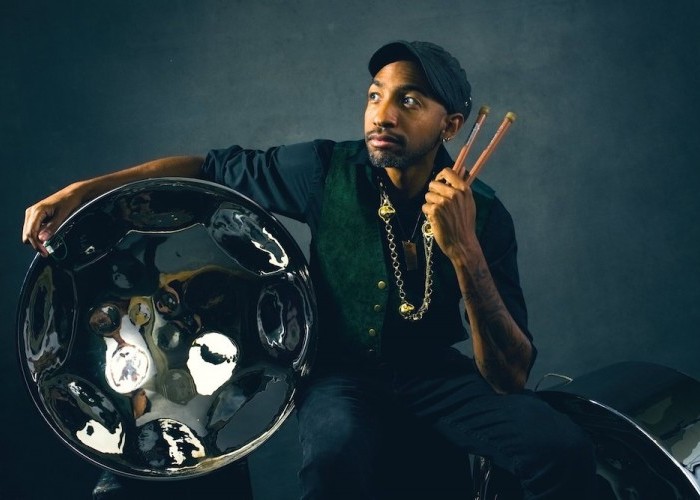Apr 2, 2024 12:59 PM
Saxophonist, Sonic Explorer Casey Benjamin Dies at 45
Casey Benjamin, the alto saxophonist, vocalist, keyboardist and producer who stamped his distinctive sounds on the…

Jonathan Scales carves out a space in the jazz world for his instrument on his latest album, Pillar (Ropeadope).
(Photo: Courtesy of Artist)Béla Fleck knows a thing or two about establishing an identity in the jazz world while playing an unusual instrument. So, it made sense that the banjo player would bond with a younger jazz musician whose specialty is an unusual instrument: steel pannist Jonathan Scales.
“I see a kindred spirit in him—in his need to be the best he can be,” Fleck said. “I identify with his struggle to learn jazz on an instrument where it’s hard to find the path, because currently there isn’t a clear one for pans or banjo.”
Fleck plays with Scales and his band, Fourchestra, on “Focus Poem,” a track on Scales’ sixth album, Pillar (Ropeadope). The clipped twang of his banjo fits well with the distinctive ping of the steel pan.
“[The Flecktones] are such a big influence on me,” Scales said. “I wouldn’t be here without them. I’ve worked very hard at getting to know them, driving for hours, so I could be at their show seven hours before they went on, so I could talk to them and maybe play with them at sound check.”
Just as the banjo is closely associated with Appalachian music, the steel pan is tightly linked to Trinidadian calypso. But just as Fleck liberated his instrument, Scales has freed the pans, crafting a jazz-rock fusion on the new album, which also features trumpeter Christian Scott aTunde Adjuah, among others.
It was at North Carolina’s Appalachian State University that Scales fell in love with the pans. Due to the efforts of now-retired professor Scott Meister, the school had its own steel pan orchestra, punfully named the Steely Pan Steel Band. Oddly enough, Scales initially was not interested in the group. “My friends twisted my arm, and I joined the band,” he recalled. “I loved it. It was the perfect combination of rhythm and melody.”
In 2013, Scales dubbed his quartet the Fourchestra, and kept the name even after the group was trimmed down to a trio, which now includes bassist E’Lon JD and drummer Maison Guidry.
“When I was in college,” Scales said, “I had this idea that I would create a jazz band with steel pans and it would be totally unique. Then my friend told me, ‘Yo, Andy Narell exists.’ ... I’ve been to Trinidad three times, and I’m definitely not turning my back on tradition. But I’m going to play the music I want to play. I grew up listening to Dr. Dre and Eminem, then studying classical saxophone and orchestral and film score music. I want to get it all in there.” DB

Benjamin possessed a fluid, round sound on the alto saxophone, and he was often most recognizable by the layers of electronic effects that he put onto the instrument.
Apr 2, 2024 12:59 PM
Casey Benjamin, the alto saxophonist, vocalist, keyboardist and producer who stamped his distinctive sounds on the…

“He’s constructing intelligent musical sentences that connect seamlessly, which is the most important part of linear playing,” Charles McPherson said of alto saxophonist Sonny Red.
Feb 27, 2024 1:40 PM
“I might not have felt this way 30 to 40 years ago, but I’ve reached a point where I can hear value in what people…

Albert “Tootie” Heath (1935–2024) followed in the tradition of drummer Kenny Clarke, his idol.
Apr 5, 2024 10:28 AM
Albert “Tootie” Heath, a drummer of impeccable taste and time who was the youngest of three jazz-legend brothers…

“Both of us are quite grounded in the craft, the tradition and the harmonic sense,” Rosenwinkel said of his experience playing with Allen. “Yet I felt we shared something mystical as well.”
Mar 12, 2024 11:42 AM
“There are a few musicians you hear where, as somebody once said, the molecules in the room change. Geri was one of…

Larry Goldings’ versatility keeps him in high demand as a leader, collaborator and sideman.
Feb 21, 2024 10:45 AM
Are you having any fun? Larry Goldings certainly is. Consider just two recent examples:
Scene 1: “If anyone had…